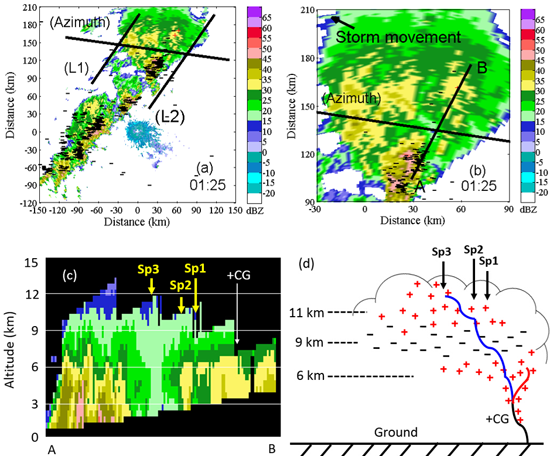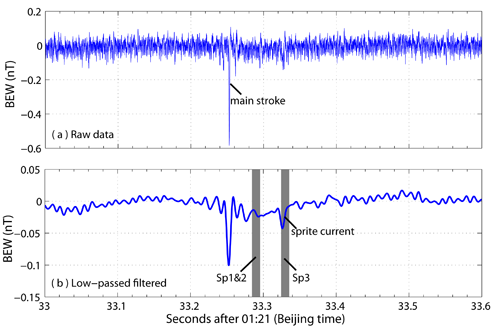Relationship between Dancing Sprite, Troposphere Thunderstorm Structure and Lightning Physical Process
Date:2015-08-17
Sprites are brief optical emissions occurring above energetic thunderstorms. A dancing sprite is a sprite during which sequential sprite elements often appear horizontally displaced from the preceding elements (just like dancing across the sky) and therefore the location of the sprite cluster center changes during its evolution. This kind of sprites usually have a long duration and often occur over comparatively large mesoscale convective systems, with a low occurrence rate. Is there any relationship between dancing sprite and the troposphere thunderstorm structure and lightning physical process?

Figure 1. Sequential images of the dancing sprite recorded on the early morning of 5 August 2012 (Yang et al, 2015)
By the joint efforts of YANG Jing, LU Gaopeng, Li-Jou LEE et al, an unusual dancing sprite event was fortunately captured in north China. Detailed comprehensive analysis of the parent storm and associated lightning activity has been made by using multiple data including low-light level observations of sprites, Doppler radar, lightning ultra-low/very low (ULF/VLF) frequency radiation. It is found that the parent cloud-to-ground lightning (CG) discharge for the sprites was only about 24 kA, and the sprite cluster (Sp1, Sp2 and Sp3 all together named a sprite cluster) did not occur right above the parent CG location and the horizontal displacement between the bright sprite element (Sp3) and the parent CG location was about at least 38 km (Figure 2c).

Figure 2. Parent thunderstorm radar echo structure (a, b, c) and the concept model of the parent CG discharge (d) (Yang et al, 2015)
The research team carefully compared the sprite element azimuth with the parent thunderstorm radar echo vertical structure, and found that the occurrence height of the sprite element may be related with radar echo top, that is, the higher the radar echo top, the higher the sprite element (Figure 2c). The Ultra-Low-Frequency radiation data further showed that all sprite elements occurred during the process of parent CG continuous current period (Figure 3b), which indicated that a comparatively large electric field in the middle and upper atmosphere was produced following the sudden removal of the charge transferred in the continuous current period, and the neutrals were ionized (by high energy electrons) and optical emissions (sprites) were observed. The above results also explained why the sprites were produced by a cloud-to-ground lightning flash with small peak current.

Figure 3. Magnetic field pulses recorded at Lulin Observatory. The parent flash pulse and sprite pulse have been shown in the figure, and the bright sprite (Sp3) occurred at about 76 ms later. All of the sprite elements occurred during the parent CG continuous current process. (Yang et al, 2015)
Reference:
Jing Yang, Gaopeng Lu, Li-Jou Lee et al. 2015: Long-delayed bright dancing sprite with large Horizontal displacement from its parent flash. J. Atmos. Terr. Phys., 129, doi:10.1016/j.jastp.2015.04.00.
Contact: Dr. YANG Jing, yangj@mail.iap.ac.cn
